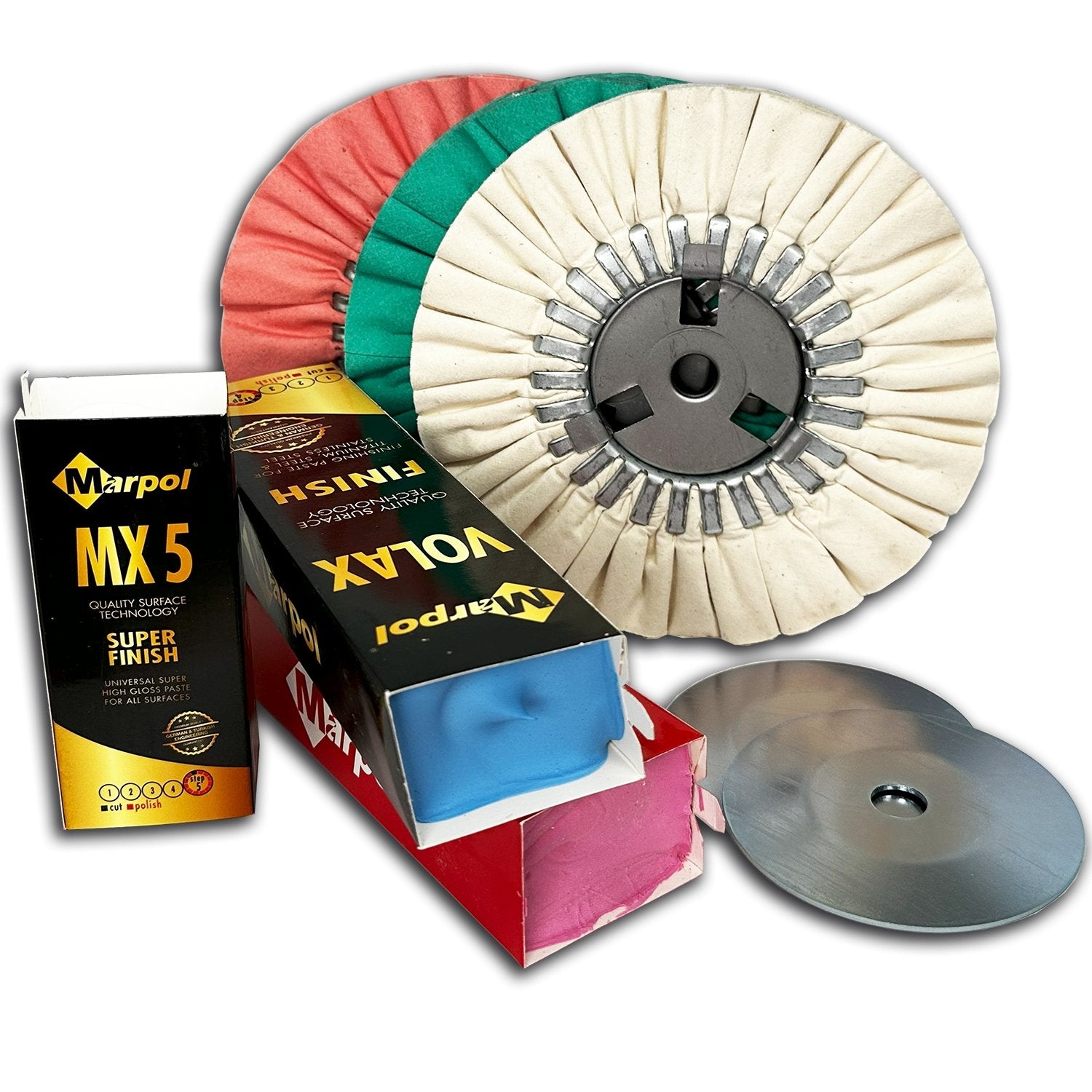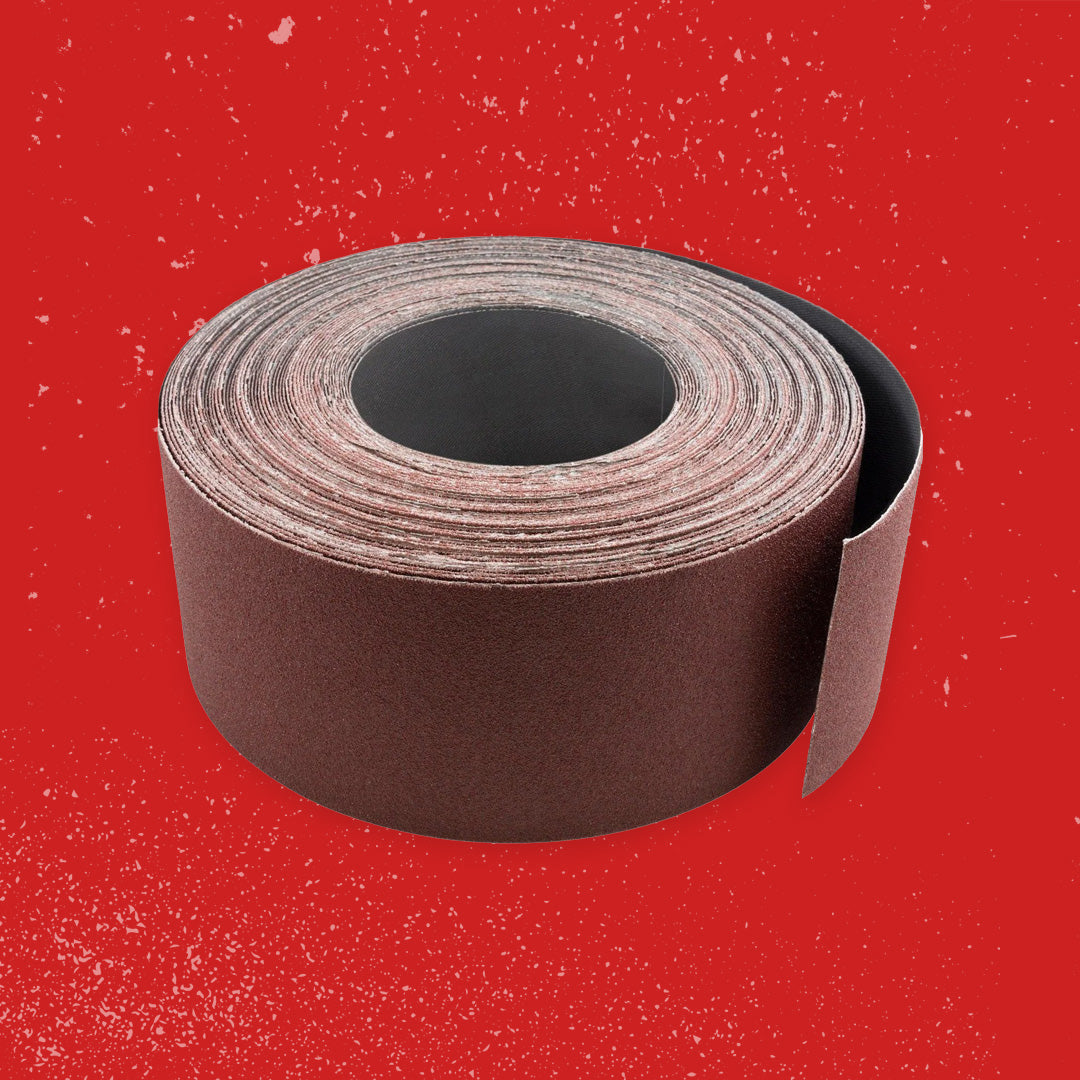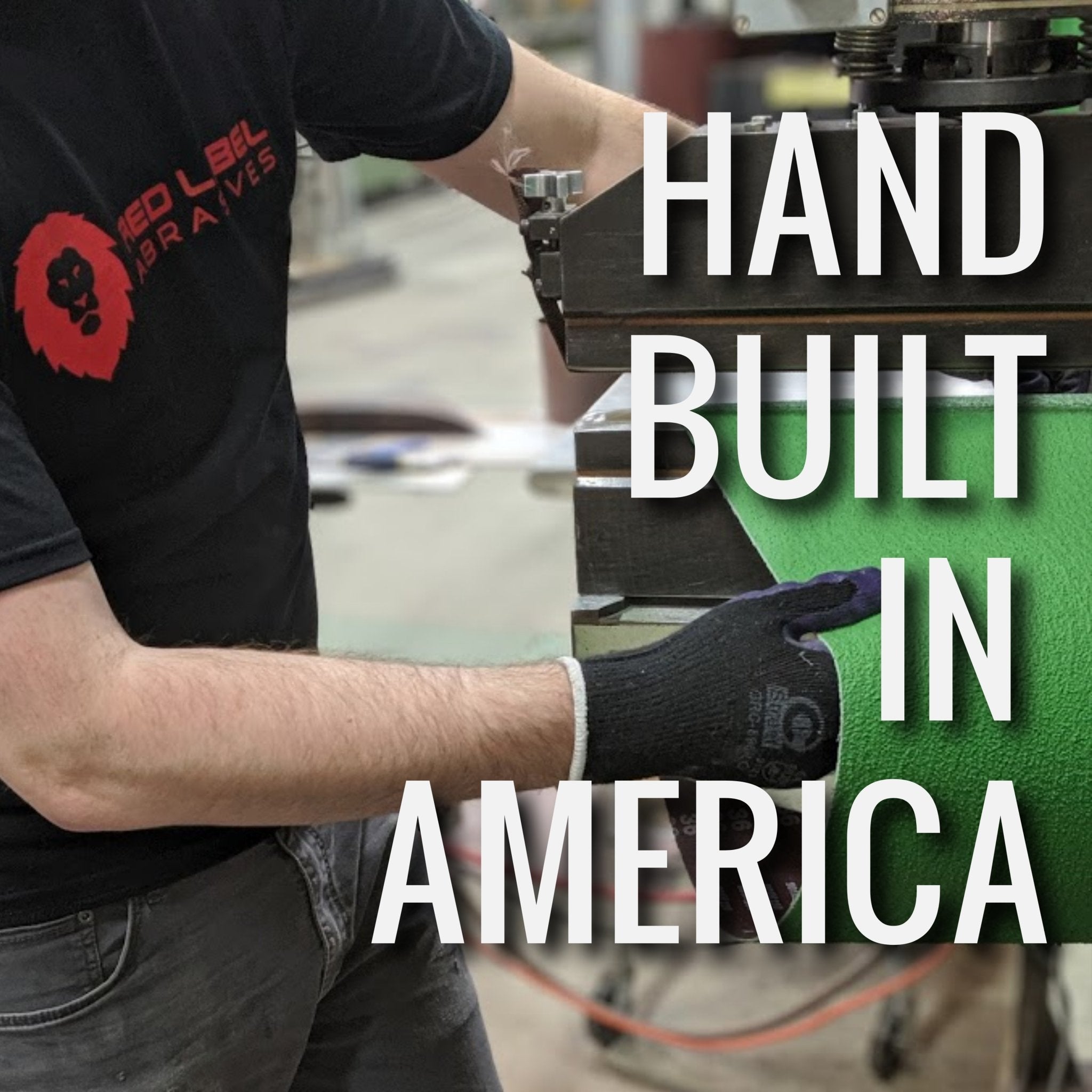Your Cart is Empty
Free Shipping over $150 (Excludes Oversized Products)
Free Shipping over $150 (Excludes Oversized Products)
Sanding Belts
Sanding Discs

The Best Ways To Sand Curved Surfaces
by David Kranker 9 min read

Quick Summary
Sanding curved surfaces takes more control than sanding flat ones, and using the wrong tools can lead to uneven finishes or damage. Flexible sanding pads, flexible sanding belts, sponges, and abrasive rolls are great for gentle curves, while drum sanders, flap wheels, and detail sanders work best for tighter or more complex shapes. Creating custom sanding blocks or using contour grips ensures consistent results on irregular or repetitive shapes. Always sand with the right grit progression and let the abrasive do the work: excess pressure or skipping grits leads to visible scratches. For metal surfaces, flap wheels and cloth-backed abrasives are the best options.
Sanding flat surfaces is straightforward; sanding curved ones is where things get tricky. Curves make it harder to maintain consistent contact, and without the right tools or sanding method, it’s easy to flatten details, leave scratch marks, or create uneven finishes that are difficult to correct later. To complicate things even further, standard sanders and rigid blocks often don’t adapt well to these surfaces, which can lead to over-sanding high spots or missing low areas entirely.
To get professional results, you need abrasives and techniques that move with the material, not against it. This guide covers the most practical tools, best sanding techniques, and proper grit selection to help you work through curved surfaces without sacrificing quality or efficiency.
Why Do Curves Need a Different Sanding Approach?
Curved surfaces make it hard for abrasives to maintain even pressure. Flat sanding blocks don’t conform to shape, and using them can flatten out high points or leave swirl marks. Excess pressure on one part of a curve can also dig into the material, creating low spots that are difficult to fix. To avoid these issues, you need abrasives that move with the surface and methods that keep your finish uniform.
1. Use Flexible Sanding Belts or Flexible Sanding Pads for Gentle Contours
For large, sweeping curves, flexible sanding pads or flexible sanding belts offer the most control. They bend with the shape of the surface, giving you better contact and a more even finish. Pads can be especially useful on bowl exteriors, table edges, curved cabinet faces, and any larger surface where a smooth, flowing line is part of the design. Flexible belts are great for curves on smaller workpieces that you can hold in your hand. They’re ideal for sanding the curve in a knife bolster, rounding out the curved parts of axe and saw handles, and more. The foam, cloth, or rubber backing compresses as you apply pressure, giving you better tactile control and helping you "feel" the surface as you work. This makes it easier to detect imperfections before they show up in the finish.
Sanding pads are also ideal for finishing large radius curves in furniture making, especially on hardwoods that tend to show every scratch. For softwoods or painted surfaces, they provide enough forgiveness to avoid over-sanding or leaving sharp transition lines.
Choosing the right grit is key. Start with 80 to 120 grit for initial shaping or removing machine marks. This range removes material quickly but still tracks smoothly over the surface. Move to 150 or 180 grit for general smoothing after shaping, which helps level out any remaining inconsistencies. For final passes before finishing or sealing, use 220 grit or finer.
Pro Tip: Look for flexible pads or flexible belts with a cloth-backed abrasive, especially when working on dense hardwoods.
2. Sanding Sponges for Tight Curves and Profiles
Sanding sponges are ideal for areas where access is limited. Their foam core allows the abrasive surface to adapt to tight curves, irregular profiles, and recessed corners that would be difficult or impossible to reach with flat sandpaper or rigid blocks. The surface stays evenly engaged with the material, helping you avoid gouges and flat spots, even when working on detailed or delicate pieces.
These sponges are especially effective for finishing and smoothing moldings, intricate trim work, and sculpted furniture elements. In situations where a standard sanding tool can’t follow the shape (like the inner edge of crown molding or the concave groove in a carved leg), a sanding sponge compresses into the shape and maintains contact without tearing or folding.
Sanding sponges come in coarse, medium, and fine grits, making them useful for everything from initial smoothing to final surface prep. Coarse grits are great for stripping finishes or leveling rough areas, while finer grits are better suited for touch-ups and pre-finishing. Because they’re washable and reusable, they last longer than typical sandpaper.
Pro Tip: Look for angled or tapered sponges if you're working on crown molding or other trim with multiple curves.
3. Contour Sanding Grips for Consistency
When you're working on repeated curves like spindles, handrails, carved chair legs, or arching trim, use contour sanding grips. These grips, made from hard plastic or rubber, are shaped to match common convex and concave profiles. Instead of trying to force flat sandpaper to follow a curve, you wrap your abrasive around the grip and use it to guide you as you sand.
Contour grips help you maintain uniformity across multiple pieces. If you're sanding a set of stair spindles or shaping several identical chair backs, these tools eliminate variation and reduce the risk of over-sanding one spot. Because the grip holds the abrasive in a fixed shape, you apply even pressure along the entire curve, which produces a cleaner, more professional finish.
You can use them on:
-
Spindles
-
Chair backs
-
Curved trim
-
Stair railings
-
Custom millwork with repeated contours
Pro Tip: Pair your grip with Red Label Abrasives sanding sheets for better performance and a longer lifespan compared to store-brand paper.
4. Custom Sanding Blocks for Unique Shapes
Not every curve fits a standard mold. When you're working on custom furniture parts, irregular shapes, or hand-carved details, off-the-shelf sanding tools won’t always deliver. Creating a custom block that perfectly matches your curve gives you total control without compromising detail or finish quality.
To make your own custom sanding block, start by tracing the exact curve of your workpiece onto a scrap piece of wood, dense foam, or medium-density fiberboard. Then, cut and shape the block to match the contour. Once it’s ready, wrap the block with adhesive-backed sandpaper.
This approach is especially useful for:
-
Custom carvings
-
One-off furniture parts
-
Irregular profiles in wood, plastic, or even soft metals
Because the block mirrors the shape of your workpiece, you’re able to apply even pressure across the surface, avoid over-sanding in concentrated areas, and maintain the design’s original flow.
Pro Tip: Keep a few custom blocks on hand for repeated use during a project.
5. Abrasive Rolls for Cylindrical Surfaces
Abrasive rolls are ideal for wrapping around curved surfaces, allowing you to sand smoothly along the full contour without gaps or pressure points. Unlike precut sheets or rigid tools, rolls let you control the width, tension, and motion with precision. Use them on:
-
Stair spindles and balusters
-
Metal tubing and railings
-
Pipe fittings and cylindrical parts
To use them, cut a strip that matches the width of the surface you’re working on. Wrap the abrasive around the curve and pull it back and forth in a shoeshine-style motion. This technique distributes pressure evenly, keeps the sanding lines consistent, and prevents flat spots from forming.
Cloth-backed abrasive rolls are especially well-suited for this kind of work. They resist tearing, maintain their grip around the surface, and flex easily without losing cutting power. Paper-backed alternatives tend to crack or bunch, making them unreliable on curves.
Pro Tip: Keep multiple grit options on hand so you can move from aggressive material removal to fine finishing without changing tools. A tighter wrap gives you more control for detail work, while a looser wrap covers more surface for faster sanding.
6. Drum Sanders for Concave Curves
When you're sanding inside curves, concave edges, or recessed shapes, drum sanders offer precision and control that flat abrasives can’t match. The cylindrical shape of the drum naturally fits into curved recesses, maintaining consistent contact with the surface and allowing for smooth, even passes. These tools rotate at high speed, removing material efficiently without flattening or distorting the arc of your workpiece.
There are two main types to consider:
-
Oscillating Spindle Sanders: Ideal for larger woodworking projects where you're shaping or refining wide concave curves. The oscillating motion helps reduce heat buildup and minimizes the chance of leaving grooves.
-
Drum Attachments for Drills or Rotary Tools: Perfect for tighter spaces, smaller parts, or detailed curves. These attachments are great for hobby work, instrument building, or furniture components with compact recesses.
Use drum sanders on:
-
Guitar bodies and cutaways
-
Bowl interiors and turned vessels
-
Furniture joints and curved joinery
Pro Tip: Don’t apply excessive pressure. Let the drum do the cutting. Too much force can overheat the surface or wear down one side of the drum unevenly. For best results, work in light, steady passes and match your grit to the sanding stage.
7. Flap Wheels for Curved Metal Surfaces
Built with overlapping abrasive flaps mounted around a hub, these wheels adapt to contours as they spin, making them ideal for curved edges, weld blending, and surface prep on rounded parts. As the wheel wears down, fresh abrasive is continually exposed, ensuring consistent performance throughout the life of the wheel.
Use flap wheels on:
-
Motorcycle frames and tubing
-
Exhaust systems and manifolds
-
Custom metal brackets and hardware
They can be mounted on angle grinders, bench grinders, or die grinders, depending on the wheel size and the scale of your project. Coarser grits are excellent for removing weld slag, rust, or mill scale, while finer grits are perfect for smoothing surfaces before painting or coating. Their ability to contour makes them especially useful on rounded transitions where flat abrasives would gouge or skip.
Pro Tip: Always keep the wheel moving in a steady motion to avoid overheating the metal. Excessive friction can lead to discoloration, warping, or premature wear of the abrasive. For stainless steel or aluminum, use non-loading flap wheels to maintain surface quality and reduce clogging.
8. Detail Sanders for Inside Corners and Small Profiles
Palm-style detail sanders are built for precision. Most models come with triangular tips or pointed heads that allow you to follow small-radius curves, reach into corners, and sand along detailed edges without damaging surrounding surfaces.
You should use detail sanders on:
-
Furniture joints with curved or recessed angles
-
Trim corners that require careful edge blending
-
Cabinet inlays and decorative profiles with limited access
These sanders are particularly helpful for finish prep and touch-up work where control is more important than speed. Many models feature interchangeable pads in various shapes, giving you the flexibility to match the sanding head to the contour or curve of your project. This makes them ideal for tasks that involve multiple profiles in a single piece.
Pro Tip: Let the sander do the work. Forcing it into tight corners or over-complicating the motion can damage the detail and shorten the life of the pad. Choose the right grit for the task and guide the tool gently to get clean, controlled results without over-sanding.
9. Flex Shaft Tools with Sanding Drums
Flex shaft tools are used to sand small, curved, or detailed areas beyond the reach of standard equipment. With a motorized base and a flexible, cable-driven shaft, these tools let you attach small sanding drums or specialty accessories and guide them by hand. The lightweight handpiece gives you full control over speed, angle, and pressure, making it perfect for intricate work.
Use flex shaft tools on:
-
Instrument-making, such as refining the curves of guitar bodies or violin scrolls
-
Jewelry work where small, curved surfaces need polishing or smoothing
-
Hobby parts and models that require detailed sanding in tight areas
These tools often feature variable speed settings and support a wide range of attachments, from sanding drums to polishing wheels. Because you can fine-tune both motion and speed, flex shaft tools are especially useful for delicate curves and light-touch surface prep.
Pro Tip: Stick with fine grits and use minimal pressure. Removing too much material can flatten edges or erase design elements. Work slowly and inspect your progress frequently to preserve the integrity of your piece.
10. Hand Sanding for the Final Finish
Hand sanding is the final step that brings everything together. It removes subtle marks left by power tools, softens edges, and ensures a clean, uniform finish across curved surfaces. You should use hand sanding for:
-
Final passes over shaped furniture parts
-
Blending machine-sanded curves into adjoining areas
-
Surface prep before staining, painting, or sealing
Tear or cut your abrasive sheets into narrow strips or custom shapes that fit your curve. For wood, always sand in the direction of the grain, even on rounded or contoured areas, to prevent visible scratches. On metal, use smooth, even strokes to maintain consistency without overworking one section of the curve.
Pro Tip: Use higher grits like 220 to 320 for the final stage, and don’t rush it. Hand sanding gives you the chance to catch flaws that machines miss, and when done right, it’s the step that sets your finish apart.
Tool and Grit Selection Chart
Here’s a quick reference guide to match tools and grits with your material and curve type.
|
Curve Type |
Tool |
Grit Range |
Material |
|
Wide and gentle curve |
Flexible pad or belt |
80-220 |
Wood, plastic, metal |
|
Tight interior curve |
Sanding sponge |
100-180 |
Wood, paint |
|
Concave curves |
Drum sander |
80-240 |
Wood |
|
Metal tubing |
Flap wheel |
60-240 |
Steel, aluminum |
|
Small detail curve |
Detail sander |
120-320 |
Wood, laminate |
|
Cylindrical shape |
Abrasive roll |
80-240 |
Wood, metal |
Sand Curved Surfaces More Easily With Red Label Abrasives
Sanding curved surfaces doesn’t have to be frustrating or time-consuming. With the right combination of tools, grit, and technique, you can handle contoured shapes just as efficiently as flat ones. Match your sanding method to the shape of the surface, let the abrasive do the work, and focus on control instead of force.
Red Label Abrasives has a full line of sanding rolls, sanding belts, sanding discs, and specialty products that deliver consistent results on every curve, corner, and contour. For more information or to place an order, call 844-824-1956 or fill out our contact form today.
ABOUT THE AUTHOR
David Kranker is a writer and creative maker who has been covering the abrasive industry on the Red Label Abrasives Blog since 2020. David spends his time continually researching sanding techniques to provide readers with the latest and greatest information. In his free time, David utilizes abrasives for many different home and auto projects at his home in Delton, MI.
Our Most Popular Abrasives

EdgeCore Ceramic Sanding Belts

EdgeCore Ceramic Flap Discs

Buffing Kit
Shop By Product Category





Why Choose Red Label?







